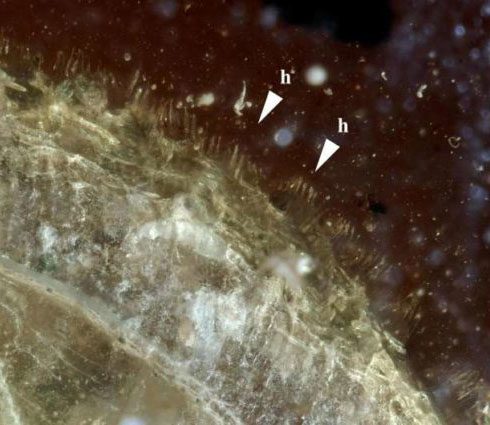A newly discovered species of hairy land snail has been found perfectly preserved in a piece of 99-million-year-old Mesozoic amber. The fuzzy mollusk has been named Archaeocyclotus brevivillosus, deriving from the Latin “brevis” meaning small, and “villōsus” meaning hairy.
The specimen was first collected before 2017 from an amber mine in the Hukawng Valley in Burma. Observed using a combination of classical microscopy and 3D X-ray micro-computed tomography, the snail measures 26.5 millimeters (1 inch) in length and 21 millimeters (0.8 inches) wide, and is 9 millimeters (0.4 inches) tall with fine hairs just 150-200 micrometers in length running along its shell.

Close-up of the tiny hairs along the snail’s shell. Image credit: Senckenberg
Of the eight species of the Cyclophoridae family that were collected from Burmese amber, six were found to have these fuzzy shells. Formed from the uppermost proteinaceous layer of the shell, these fine hairs are not uncommon on the shells of both living and extinct land snails from several different families. The convergent evolution of these distinct families suggests there is a significant evolutionary advantage to having a hairy shell.
“[They] could improve the animals’ ability to better cling to plant stalks or leaves – something that has already been observed in present-day snails,” explained Dr Adrienne Jochum from the Senckenberg Research Institute and Natural History Museum in Frankfurt, and the Natural History Museum in Bern, in a statement.
Additionally, Jochum explained, the hairs are thought to play a role in thermal regulation by enabling water droplets to adhere to the shell. They may have also aided in the prevention of erosion by acidic soil and leaf litter while serving as a form of camouflage and perhaps even playing a role in mate selection.
The presence of such hairs on the majority of the cyclophorid species found in the Cretaceous Burmese amber suggests that this is the ancestral state of the land snails. The hairs may even have played a role in the group’s terrestrialization during the Mesozoic period, seeing the snails transition from water to land between 252 and 66 million years ago.
Myanmar amber plays a huge role in the preservation of ancient species in an environment otherwise perfectly suited to the disintegration of organic material. Over 2,000 unique species from the Cretaceous period have been found preserved in Myanmar amber, including an unusual viviparous snail encased with its freshly born young.
These detailed preservations enable researchers to fill in gaps in the fossil record and study unique physical features of long-extinct specimens.
The paper is published in Cretaceous Research.
Source Link: 99-Million-Year-Old Hairy Snail Found Preserved In Amber